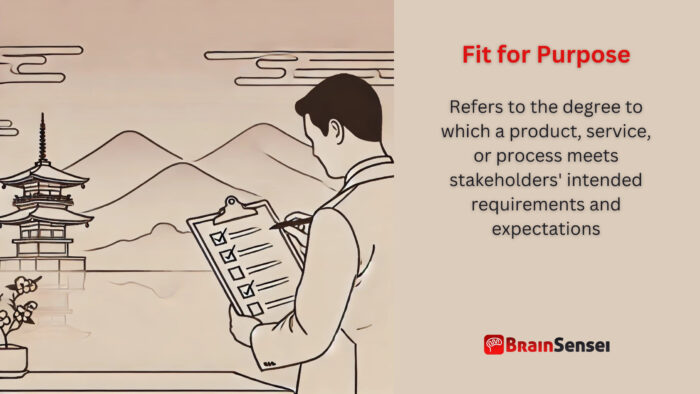
Fit for Purpose
What is Fit for Purpose?
In project management, “fit for purpose” refers to the degree to which a product, service, or process meets stakeholders’ intended requirements and expectations. It ensures that deliverables are functional but also relevant and practical in their application.
Key Takeaways
- Focuses on meeting stakeholder expectations and project goals
- Ensures products or services are relevant, usable, and practical
- Helps prioritize performance and value over unnecessary features
- Aligns with quality standards and customer satisfaction
- Essential for project success and long-term sustainability
Understanding Fit for Purpose
How It Works
‘Fit for Purpose’ is not a solitary endeavour but a collaborative effort that evaluates whether a deliverable meets its intended objectives rather than just adhering to technical specifications. It requires thorough requirements gathering, stakeholder communication, and quality assurance throughout the project lifecycle. Your active participation is crucial to its success.
Note
- Misunderstanding stakeholder requirements can lead to technically correct but practically unusable deliverables. This can result in wasted resources, project delays, and ultimately, dissatisfaction among stakeholders. Therefore, it’s crucial to ensure clear and effective communication with all stakeholders throughout the project.
- Regular feedback loops are the backbone of relevance and performance, providing reassurance and confidence.
- Fit for Purpose doesn’t necessarily mean the highest quality but the most appropriate for the given needs.
- It requires balancing cost, quality, and performance.
Related Terms
- Quality Assurance (QA): Processes to ensure deliverables meet established standards
- Requirements Gathering: The practice of collecting and documenting stakeholder needs
- User Acceptance Testing (UAT): Testing to confirm that a system meets business requirements
- Performance Metrics: Quantifiable measures used to assess performance and effectiveness
- Continuous Improvement: Ongoing efforts to improve products, services, or processes
Examples of Fit for Purpose
Manufacturing Industry
A manufacturing company producing automotive parts ensures their components meet safety regulations and customer specifications. By implementing a robust quality control system and gathering customer feedback, the company guarantees that the parts are “fit for purpose” for various automobile brands. The company uses statistical process control (SPC) to monitor production and identify deviations from required standards. Quality engineers conduct regular audits and inspections to ensure compliance with both domestic and international safety regulations. Additionally, the firm collaborates with clients to gather insights into performance in real-world conditions, leading to continuous improvements. For instance, after receiving feedback about inconsistent part dimensions, the company revamped its calibration procedures, resulting in a 15% reduction in defects.
The company also invests in staff training programs, consistently applying quality control techniques across production lines. This investment has resulted in a strong reputation for reliability in the automotive industry. This commitment to delivering “fit for purpose” products meets regulatory requirements and exceeds customer expectations, leading to increased orders and client satisfaction.
Healthcare Industry
A healthcare provider develops a new patient management system to streamline administrative processes and improve patient care. Through iterative testing and feedback from medical professionals, the development team adjusts the software to serve end-users better, demonstrating its “fit for purpose.” The team uses agile methodologies to incorporate feedback from nurses, doctors, and administrative staff throughout the design process. Initially, users reported difficulty navigating the interface, which delayed patient check-ins and increased frustration.
The project illustrates the importance of understanding user needs and responding to feedback. Your insights are invaluable, and you feel integral to its success.
Telecommunications Industry
A telecom company launches a new mobile application for customer self-service. User testing reveals that the app meets functionality requirements but needs better interface design. By addressing these concerns, the company ensures that the app is genuinely “fit for purpose.” The initial app allows users to check account balances, manage subscriptions, and pay bills. However, customer feedback highlights issues with navigation and slow load times.
The telecom company optimized the app’s performance to address these concerns, reducing load times by 40%. It also introduced a more intuitive layout guided by user experience (UX) best practices. Additionally, the company implemented an in-app feedback feature to gather user insights continuously. Post-launch analytics indicated a significant increase in customer satisfaction and engagement, with a 30% rise in monthly active users. This case underscores the importance of aligning product design with customer expectations to achieve “fit for purpose” outcomes.
Use Cases of Fit for Purpose
United States (Software Development)
A U.S.-based software company builds a new CRM system for a retail client. The team ensures the software aligns with sales processes and customer service requirements by conducting stakeholder interviews, making the system “fit for purpose.” The project team collaborated with sales and marketing departments to gather detailed requirements and understand users’ day-to-day challenges. They implemented regular review sessions and prototypes to incorporate feedback promptly. Upon deployment, the CRM system streamlined customer interactions and increased sales team productivity by 30%, demonstrating the importance of aligning product features with business needs.
The company also ensured robust support and training programs to facilitate smooth adoption. User feedback highlighted the intuitive interface and efficient reporting capabilities, emphasizing how close collaboration with stakeholders can yield deliverables that meet practical business requirements.
Germany (Construction Industry)
A construction firm in Germany uses fit-for-purpose principles to ensure that building materials and structural designs meet regulatory standards and client expectations, ensuring safety and satisfaction. The project involved constructing a commercial complex with stringent environmental and safety requirements. Early in the planning phase, the project team engaged with engineers, architects, and regulatory authorities to identify critical requirements. Engineers conducted regular inspections and material testing to maintain adherence to quality standards.
Additionally, the firm utilized building information modelling (BIM) tools to visualize project progress and proactively identify potential issues. The completed complex met all legal and safety standards and received positive tenant feedback for its functional design and energy efficiency. This case illustrates the value of comprehensive planning and continuous quality monitoring in achieving “fit for purpose” outcomes.
Japan (Manufacturing Industry)
A Japanese electronics manufacturer applies “Fit for Purpose” by regularly assessing production standards against consumer needs, ensuring consistent product reliability and customer satisfaction. The company implemented a customer feedback loop, allowing them to gather insights on product performance and user satisfaction. Based on this feedback, they adjusted manufacturing processes to address identified issues, such as improving battery life and optimizing product ergonomics.
The company also introduced cross-functional teams to evaluate product designs from multiple perspectives. As a result, they significantly reduced product returns and enhanced their market competitiveness. This example demonstrates how proactive feedback collection and process adjustments are essential for maintaining product relevance and reliability.
Best Practices of Fit for Purpose
To ensure deliverables are “fit for purpose,” project managers should follow these best practices:
Clear Requirement Definition
Begin with a comprehensive understanding of stakeholder needs. Engage with stakeholders through workshops, interviews, and surveys to gather requirements accurately. Misaligned requirements can lead to products that are technically sound but practically ineffective.
Effective Communication Channels
Establish open and transparent communication channels. Conduct regular meetings, status reports, and collaborative tools to bridge gaps between different teams and ensure alignment on project goals.
Iterative Testing and Feedback
Implement iterative testing cycles to identify and address issues early. User acceptance testing (UAT), beta testing, and pilot programs allow real-world feedback, ensuring the product meets practical needs.
Performance Monitoring and Evaluation
Monitor performance against project goals using key performance indicators (KPIs). Tools like dashboards and analytics platforms help track progress and identify areas for improvement.
Training and Knowledge Transfer
Provide adequate training and resources to end-users. A well-designed product can fail to deliver value if the project team does not equip users to utilize it effectively.
Continuous Improvement
Adopt a mindset of continuous improvement. Post-project reviews, lessons-learned sessions, and feedback loops contribute to long-term success.
Risk Management
Identify potential functionality, usability, and performance risks early in the project. Develop mitigation strategies to address these risks proactively.
Ignoring these best practices can lead to project delays, cost overruns, and stakeholder dissatisfaction. For instance, a retail company that neglected regular feedback cycles launched an e-commerce platform with poor navigation, which decreased sales and caused user frustration.
Common Mistakes and Issues
One common mistake is equating high quality with Fit for Purpose. Quality is essential, but a product can be high-quality without meeting stakeholder needs. For example, a software application might have advanced features but fail to provide the core functionality users require.
Another significant issue is inadequate requirements gathering. When teams do not thoroughly engage with end-users or stakeholders, they risk delivering products that fail to address real-world needs. Miscommunication between departments can exacerbate this issue, leading to discrepancies between project goals and outcomes.
Additionally, neglecting iterative testing can produce products that appear functional on paper but fail under actual usage conditions. Continuous testing, validation, and user feedback help identify and resolve such problems early.
Lastly, resistance to change or complacency in processes can lead to stagnation. Teams that do not adopt a continuous improvement mindset may struggle to adapt to evolving requirements, ultimately delivering outdated or irrelevant products.
Frequently Asked Questions (FAQs)
What does “Fit for Purpose” mean in project management?
It refers to ensuring that project deliverables meet the intended requirements and provide stakeholders with the desired functionality and performance.
How is Fit for Purpose different from quality?
Quality focuses on adherence to specifications, while Fit for Purpose emphasizes meeting user needs and expectations.
Why is Fit for Purpose important?
It ensures deliverables are helpful, relevant, and aligned with project goals, contributing to customer satisfaction and project success.
How can you ensure a product is Fit for Purpose?
Gathering comprehensive requirements, engaging stakeholders, conducting thorough testing, and maintaining open communication.
Can something be high-quality but not Fit for Purpose?
Yes. A deliverable can exceed technical standards but fail to meet users’ practical needs, making it unfit for purpose.
Additional Resources
Preparing for a PMI certification?
- Exam Prep Courses: PMP®, CAPM®, and PMI-ACP®
- Exam Simulators: PMP®, CAPM®, PMI-ACP®, PMI-PBA®, PMI-RMP®, PMI-SP®, PgMP®, and PfMP®
- Professional Development Units (PDUs): 15, 30, and 60 PDU Bundles



